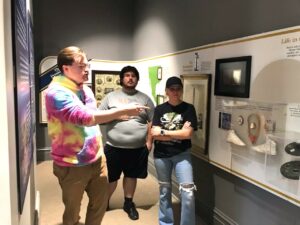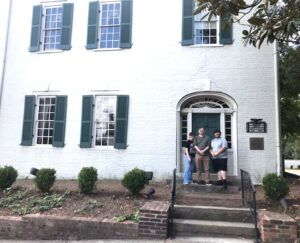COLUMBIA, TENN. – Three Tusculum University students will enhance people’s knowledge of the United States’ 11th chief executive by developing an exhibit for the President James K. Polk Home and Museum during the spring semester.

Left to right, Chris Colmer, Hughston Burnheimer and Sydney May stand inside the museum at the President James K. Polk Home and Museum.
Hughston Burnheimer and Sydney May, who are seniors, and Chris Colmer, a sophomore, will complete the project as part of their Museum Exhibits class at Tusculum. The subject matter will be Polk’s presidency, and Dr. Peter Noll, professor of public history and museum studies at Tusculum, suspects it will delve into the implications of his tenure in office. Polk was president from 1845-1849.
The exhibit is scheduled to open before the end of the spring semester.
“This is a great opportunity for our students because they will gain valuable experience working with professionals in the museum field,” Dr. Noll said. “Because the exhibit will be attached to a larger museum, they will receive more recognition for their work. It will also be a permanent exhibit at this site, so their creation will be on display well after they graduate and enter the field as career-ready professionals.”
The exact scope of the Polk exhibit will be determined as the semester begins, when Dr. Noll and the students meet with the museum’s staff. The students will prepare a planning document that includes a feasibility analysis, themes and communications goals in consultation with museum staff. At the same time, they will read about Polk as an individual as well as his presidency to gain an even greater understanding of the man and his leadership of the United States.
Students will be responsible for writing the majority of the copy and working with the designer to create a graphic theme for the exhibit. They will also be involved in the selection of objects that belong in the exhibit and then install the final product in the museum.
“We do not know at this juncture whether we will fabricate exhibit furniture or perform case work,” Dr. Noll said. “Our students will not be tasked with completing every element of the exhibit, but they will be a key partner in the whole process.”
Dr. Noll said this initiative is a great opportunity for students to work on the project with museum professionals to explore the significance of Polk’s presidency. He said the first time the United States invaded a foreign country occurred when the 11th president was in office. He said Polk’s term set a lot of precedents and had implications for the future.
“Polk’s was probably one of the more significant presidencies in the decades leading up to the Civil War,” Dr. Noll said. “He’s president during the United States’ annexation of Texas, war with Mexico and acquisition of California, Arizona and New Mexico. The acquisition of that territory is one of the major factors contributing to the Civil War because it reopened the question of the expansion of slavery into western territories.”
The Polk museum approached Tusculum about participating in this project. That aligned with Dr. Noll’s interest in directing some of the university’s exhibits courses toward off-campus initiatives. It also meshed with Tusculum’s experience working on presidential history, particularly Andrew Johnson, the United States’ 17th president. Greeneville is home to the Andrew Johnson National Historic Site, which includes a visitor center, his homestead and the cemetery where he is buried.

Left to right, Sydney May, Chris Colmer and Hughston Burnheimer stand in front of the main house at the President James K. Polk Home and Museum.
To prepare for next semester’s work, Burnheimer, Colmer and May recently visited the President James K. Polk Home and Museum to meet the staff and take measurements of the exhibit space. All three come to the project with an interest in the project as history majors. Burnheimer and May are concentrating that major in museum studies, and Colmer is pursuing a minor in that subject.
“I find the whole project appealing, but I especially find exciting the opportunity to work with an actual museum in designing an exhibit and getting to play a role in changing the way Polk and his legacy are understood and remembered,” said Colmer, whose career interests include museum work and teaching. “I think this will be invaluable in preparing me for the future of my career. Learning hands-on from experience in a real museum from someone like Dr. Noll will go a long way to preparing me for future museum work.”
May, who intends to work for the National Park Service at a historic site or museum or as a museum curator, has similar thoughts.
“I’m excited to share the broader story – the good and bad parts – of James K. Polk’s role in American history,” she said. “This project will give me practical experience and confidence in planning and creating a museum display, which will be valuable experience when I look for a job in the real world.”
Burnheimer, whose career plan is to pursue archival work, shared Dr. Noll’s viewpoint about the significance of Polk’s time in the White House.
“Polk’s presidency is not often looked at in great detail compared to some other presidencies, but his is really crucial for setting the scene for the next bit of U.S. history,” Burnheimer said. “Telling the consequences and results of his presidency is going to be really important.”
To learn more about Tusculum’s history program, please visit https://site.tusculum.edu/history/. Additional information about the museum studies concentration can be accessed at https://site.tusculum.edu/museum-studies/. Further details about the university are available at www.tusculum.edu.


